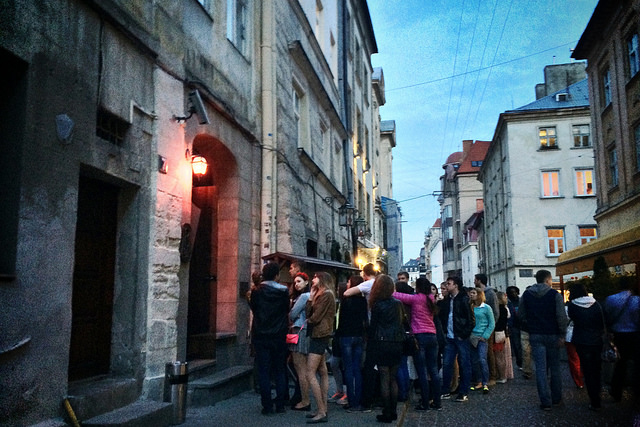Unlock the Magic in Your Story Now
Get the Free 20 questions to Ask Before Launching Your Idea workbook when you sign up for occasional updates.
Get the Free 20 questions to Ask Before Launching Your Idea workbook when you sign up for occasional updates.
Articles filed in: Storytelling
The Noisy Bell And Napkin Worthiness
filed in Marketing, Storytelling, Strategy
 John Lydgate was right, “you can’t please all of the people all of the time.”
John Lydgate was right, “you can’t please all of the people all of the time.”
And yet a huge part of our job as business leaders, entrepreneurs and product creators is to meet a standard that pleases most of the people we serve, most of the time.
Feedback—the information and reactions we receive about our products or performance is the basis for improvement, but feedback comes in different forms. It’s often what’s unsaid, the complaint that isn’t voiced or the praise that isn’t overt that’s most valuable to our businesses. The clean plate, the return visit, the website address scribbled on a lunch companion’s napkin, leave valuable clues about what’s working and what’s not.
Customer satisfaction and customer support are very different from customer awareness and customer care.
Your business needs both.
You can wear yourself down by constantly reacting to the noisy bell, or you can find more ways to pay attention to the people who think you are napkin-worthy, then work harder to create more of them.
Image by C.Foulger.
How Do You Know?
filed in Marketing, Storytelling, Strategy
 How do you know which product to launch next?
How do you know which product to launch next?
How do you know which packaging works best?
How do you know what it feels like for someone to encounter your brand?
How do you know what story your customer will tell tomorrow about the experience he had today?
What we know (or perhaps don’t yet know), about our customers should be the thing that impacts what we do now and next.
How are you getting better at knowing?
Image by Glen Scott.
The Thing About That List You’re Making
filed in Storytelling, Strategy
 Take a look at the Top 20 Book Lists of All Time on Amazon. This is what most people bought and reviewed—the books that succeeded wildly, beyond expectations. Could anyone have predicted that these would be the books that the majority embraced? Can anyone explain why?
Take a look at the Top 20 Book Lists of All Time on Amazon. This is what most people bought and reviewed—the books that succeeded wildly, beyond expectations. Could anyone have predicted that these would be the books that the majority embraced? Can anyone explain why?
Despite their outstanding success you probably haven’t read or even heard of some of them.
Now consider the books not listed, maybe they too got under someone’s skin, changed a life, sparked a great idea or launched a career.
As you set out on this brand new year you’re probably making a list of your own. You have things you want to plan for, milestones you want to reach, targets you want to hit and perhaps even a list or two you want to get on.
Remember that success is not what you read in a well-crafted bio, or see on a carefully curated Instagram feed and it may never be recognised with awards or witnessed on a list.
Success is a feeling, not a fact. You get to choose what it should feel like.
Image by Colin Knowles.
A Reputation That Precedes You
filed in Marketing, Storytelling, Strategy
 It’s 5pm, still thirty minutes to go before Mr Wong opens its doors for dinner. The line snakes down the street and around the corner. A few people have bookings for tables of six or more, but not many, most are walk-ins who know that if you’re not dining with a bigger group and have no reservation (house rules), then you need to get there early. Mr Wong’s reputation precedes it.
It’s 5pm, still thirty minutes to go before Mr Wong opens its doors for dinner. The line snakes down the street and around the corner. A few people have bookings for tables of six or more, but not many, most are walk-ins who know that if you’re not dining with a bigger group and have no reservation (house rules), then you need to get there early. Mr Wong’s reputation precedes it.
There is clearly no time for the management to worry about what the dozen other restaurants within walking distance are doing and no urgency to allocate resources to traditional marketing campaigns.
Like the Mr Wong team every one of us has a choice. We can spend the majority of our time either managing our reputation or keeping pace with our competitors or we can deliberately create the reputation that precedes us.
What’s the story you want customers to tell about your brand? [Take time to write it down].
How will you make that happen?
Image by deepstereo.
The Three Marketing Superpowers—Judgement, Empathy And Timing
filed in Marketing, Storytelling, Strategy
 Just two days before Christmas while every other retailer was happily dealing with long lines, the outdoor clothing and travel equipment store was empty. Not a customer in sight. They should have been doing a brisk trade in torches, camping accessories and stocking fillers, yet the assistants had plenty of time to finesse the ‘Boxing Day Sale’ window display. Large red signs announcing that in just three days things might be cheaper filled every window, reminding passers-by about buyer’s remorse right when they were in the mindset to make a purchase.
Just two days before Christmas while every other retailer was happily dealing with long lines, the outdoor clothing and travel equipment store was empty. Not a customer in sight. They should have been doing a brisk trade in torches, camping accessories and stocking fillers, yet the assistants had plenty of time to finesse the ‘Boxing Day Sale’ window display. Large red signs announcing that in just three days things might be cheaper filled every window, reminding passers-by about buyer’s remorse right when they were in the mindset to make a purchase.
This error in judgement, empathy and timing led to a slew of operational decisions, the impact of which couldn’t be undone. The ability to stand in the customer’s shoes and to see the world as they do is the most underrated marketing tool we have.
Image by Gerard Stolk.
When The Marketing Works
filed in Marketing, Storytelling, Strategy
 We spend so much of our time in ‘push mode’ that we can forget to celebrate what went well or to evaluate why. When you make the sale it’s natural to begin working out how to make the next one.
We spend so much of our time in ‘push mode’ that we can forget to celebrate what went well or to evaluate why. When you make the sale it’s natural to begin working out how to make the next one.
We make the next one by working out why we made the first.
It’s important to spend as much time questioning why the story resonated, as you do working out how to tell it.
Image by Baptiste Pond.
Design For The Outcome You Want
filed in Marketing, Storytelling, Strategy
 Susan is the VP of Sales at a large company. She’s more than a little frustrated that her sales team keep selling legacy products to customers and don’t make the effort to introduce new product lines to them instead. Of course it’s easier for the sales guy to earn his bonus by filling repeat orders than it is to spend valuable time educating customers about what’s new and what the future might look like. And so the cycle perpetuates because of the way the sales team is compensated and rewarded.
Susan is the VP of Sales at a large company. She’s more than a little frustrated that her sales team keep selling legacy products to customers and don’t make the effort to introduce new product lines to them instead. Of course it’s easier for the sales guy to earn his bonus by filling repeat orders than it is to spend valuable time educating customers about what’s new and what the future might look like. And so the cycle perpetuates because of the way the sales team is compensated and rewarded.
Joe is an electrician, he has four children and his wife works full time, so he purposely doesn’t work 9 to 5. He’s designed his business to serve people who need an emergency call out service that operates after hours, when all of the other electricians in his area have gone knocked off for the day. Joe’s mobile phone number is the most visible thing on his website and that, along with his hours of operation are the main calls to action. Because of this he only gets relevant calls and doesn’t have to field enquiries from the kind of customers he doesn’t want to work with.
Messina sells the best gelato in Australia, and so they are not short of customers even on a cold winter Wednesday evening. In a world and an area where nobody carries cash, Messina runs a ‘cash only’ payment system in order to keep the lines running smoothly. Every Melburnian knows that if you want the best Salted Coconut and Mango Sorbet in Australia you’ll need to bring cash. In the end the constraints of the system the company has put in place creates a better experience for their customers.
For every action you take in your business, every signal you send and story you tell there will be a reaction from your customers. We often overlook the power the choices we make have to shape what will happen next.
What do you want your customer to do in the moment?
What does he need to know in order to be able to do that?
What systems and processes do you need to put in place to help him?
When you design your business (health care system, company, platform, family and on and on) for the outcomes you want, you not only get them, but your customers and your teams thank you for lighting the way.
Image by Ivano Bellini.
Where’s Your Magic?
filed in Marketing, Storytelling, Strategy
 The long Sunday morning croissant line at Lune moves slowly and never gets any shorter.
The long Sunday morning croissant line at Lune moves slowly and never gets any shorter.
Not a single person in the queue complains or shoots a frustrated glance at the time that is clearly slipping by.
The servers work slowly, carefully boxing each pastry as if it were made of porcelain. All the while the bakers roll fresh croissants in full view, like performers in an open air theatre playing to the crowd.
The barista comes outside and takes coffee orders as the people further up the line exit with the distinctive custom made box (complete with steam vents in the lid) because of course if you’re going to queue for a $5.50 croissant, you don’t just buy one—you leave with a box full and a story.
My millennial sons become frustrated. They know the assistants could make the line go faster–much faster and yet they seem to deliberately stifle efficiency.
The unspoken truth is that without the twenty minute wait a Lune croissant loses its magic. That line is part of the story. If Lune was open seven days, not just on weekends and if orders weren’t limited to six per customer. If they didn’t sell out and if you could simply walk right in and get served straight way the story wouldn’t be what it is. The scarcity and the story make the product better. The team at Lune understand where the magic happens. Where is yours?
Image by Enrico Sola.
 It’s never a good sign when a flight doesn’t board on time. When the ground staff make announcements about ‘engineering faults’ and begin handing out meal vouchers you know you’re in trouble. And so it went last month for flight 029 to Hong Kong. Three hours after the first announcement the flight was cancelled, leaving the ground staff with five hundred customer service issues to deal with in one hit. No wonder few airlines do this well.
It’s never a good sign when a flight doesn’t board on time. When the ground staff make announcements about ‘engineering faults’ and begin handing out meal vouchers you know you’re in trouble. And so it went last month for flight 029 to Hong Kong. Three hours after the first announcement the flight was cancelled, leaving the ground staff with five hundred customer service issues to deal with in one hit. No wonder few airlines do this well. Joe was in a real fix. The equipment he’d been scheduled to hire from the builder’s supplier had accidentally been hired to another customer, there wasn’t an alternative machine available for a month. Joe needed to do something fast, if he didn’t the job he was working on would be behind time by weeks and this delay would have a knock on effect on the whole project, impacting not just him, but other tradespeople and most importantly his client.
Joe was in a real fix. The equipment he’d been scheduled to hire from the builder’s supplier had accidentally been hired to another customer, there wasn’t an alternative machine available for a month. Joe needed to do something fast, if he didn’t the job he was working on would be behind time by weeks and this delay would have a knock on effect on the whole project, impacting not just him, but other tradespeople and most importantly his client.